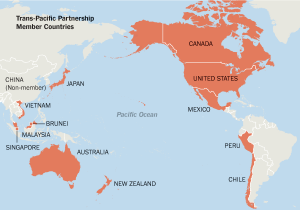The Trans-Pacific Partnership — friend or foe to the environment?
![]() By Megan Strachan & Mark L. Madras
By Megan Strachan & Mark L. Madras
On October 5, 2015, Canada announced that it had concluded negotiations of the Trans-Pacific Partnership (“TPP”). The TPP is a free trade agreement which will provide Canada with preferential and unprecedented access to the Asia-Pacific Region.
The TTP is currently comprised of twelve Pacific-rim countries, representing a market of 800 million people. The TTP will need to be ratified by party, including Canada, before it will come into force.
For an overview of the TPP, please click here.
While the text of the TPP is not yet available, a technical summary of these environmental commitments is available online. Canada has indicated that the text of the TTP will be made available once the technical review, translation, and legal review are completed.
Free trade agreements like the TTP raise concerns that environmental standards may be modified or undercut in order to improve competitiveness. Member countries may be incentivized to lower environmental standards to promote trade or attract investment. The TTP has sought to discourage that tendency with a set of environmental commitments built into the agreement.
Free trade agreements may prevent parties from developing or modifying domestic environmental laws to impose stricter environmental standards. Strict environmental standards can be seen as barriers to trade and labelled as protectionism. Thus, free trade agreements can discourage the development and implementation of new measures to protect the environment.
The TTP includes commitments to hold parties accountable in their implementation of multi-lateral environmental agreements. This should result in parties being subject to the same laws and policies designed to protect the environment, rather than developing individual standards. This approach attempts to balance the basic principles of free trade with environmental protection. It remains to be seen how successful this method will be.
The environmental commitments in the TPP appear to be wide ranging, from obligations to enforce environmental laws (and not to soften the laws to promote trade), to commitments to encourage corporate social responsibility and voluntary measures.
Of particular interest will be the structure of provisions to address certain “global environmental challenges”, such as combating illegal fishing, logging, and wildlife trade; promoting the conservation of biodiversity and protecting the marine environment; and addressing climate change.
Canada, as a nation with one of the world’s most valuable commercial fishing and logging industries, may be impacted positively by these commitments. With the upcoming Conference of the Parties in Paris later this year, the climate change measures in the TTP are also of great interest.
The TTP also calls on parties to fulfill their pre-existing obligations under other multi-lateral agreements, such as the Montreal Protocol on Substances that Deplete the Ozone Layer. The complete list of obligations is not currently available. It may include agreements that Canada is not currently a party to, and may provide additional pressure on Canada to ratify those agreements, if any, as well as to fully implement the agreements that it has ratified.
The TTP also establishes a framework for cooperation in support of the environmental commitments, such as technical assistance and informational exchange, tying in with its commitment to encourage trade in environmental goods and services. This may result in burgeoning opportunities for Canada in, for example, the area of renewable energy technology.
Significantly, the TTP includes an independent and binding dispute resolution process to address environmental compliance questions (and any other compliance issue). Consultation and cooperation are the preferred methods of resolution for any dispute under the TTP, but if that fails then parties have access to the TTP dispute settlement mechanism, which is modelled on that of the World Trade Organization.
The TTC pledges to have panellists with the appropriate expertise to resolve disputes in specialized areas such as the environment. More on the dispute resolution mechanism is available here.
While free trade agreements are often viewed skeptically by environmentalists, the TTP has promised to offer the “most ambitious set of environmental commitments to date, targeting a wider range of trade-related environmental priorities.”1
Time will tell if the TPP’s innovative approach is a model for the future of environmentally-conscious free trade, or whether the environment will continue to take a back seat to increased economic growth.
1 Foreign Affairs, Trade, and Development Canada, Environment – Technical Summary of Negotiated Outcomes: Environment Chapter, available online here . This article first appeared on the Gowlings website and is reprinted here with the kind permission of the author



